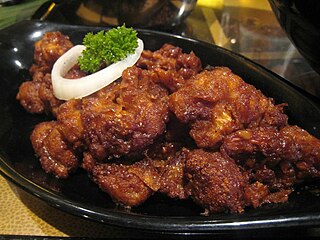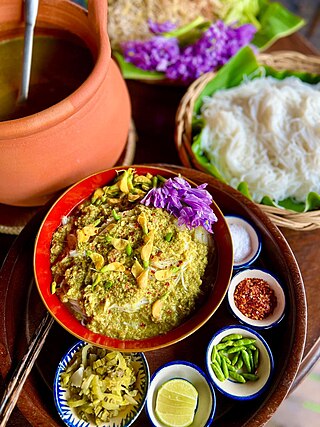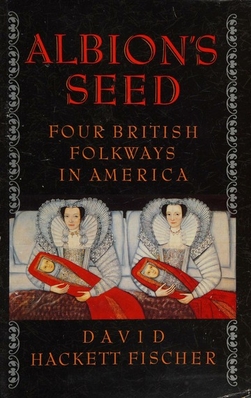Related Research Articles

Fusion cuisine is a cuisine that combines elements of different culinary traditions that originate from different countries, regions, or cultures. Cuisines of this type are not categorized according to any one particular cuisine style and have played a part in many contemporary restaurant cuisines since the 1970s.

Soul food is the ethnic cuisine of African-Americans. It originated in the American South from the cuisines of enslaved Africans trafficked to the North American colonies through the Atlantic slave trade during the Antebellum period and is closely associated with the cuisine of the American South. The expression "soul food" originated in the mid-1960s, when "soul" was a common word used to describe African-American culture. Soul food uses cooking techniques and ingredients from West African, Central African, Western European, and Indigenous cuisine of the Americas. Soul food came from the blending of what African Americans ate in their native countries in Africa and what was available to them as slaves. The cuisine had its share of negativity initially. Soul food was initially seen as low class food, and Northern African Americans looked down on their Black Southern counterparts who preferred soul food. The term evolved from being the diet of a slave in the South to being a primary pride in the African American community in the North such as New York City.
Breakfast is the first meal of the day usually eaten in the morning. The word in English refers to breaking the fasting period of the previous night. Various "typical" or "traditional" breakfast menus exist, with food choices varying by regions and traditions worldwide.

A fad diet is a diet that is popular, generally only for a short time, similar to fads in fashion, without being a standard scientific dietary recommendation, and often making unreasonable claims for fast weight loss or health improvements; as such it is often considered a type of pseudoscientific diet. Fad diets are usually not supported by clinical research and their health recommendations are not peer-reviewed, thus they often make unsubstantiated statements about health and disease.

Cambodian cuisine combines the culinary traditions of many different ethnic groups in Cambodia, an important subset of which is Khmer cuisine, the nearly-two-thousand-year-old culinary tradition of the majority Khmer people. Over centuries, Cambodian cuisine has incorporated elements of Indian, Chinese, Portuguese and French cuisine, and due to some of these shared influences and mutual interaction, it has many similarities with the cuisines of Central Thailand, and Southern Vietnam and to a lesser extent also Central Vietnam, Northeastern Thailand and Laos.

Gastronomy is the study of the relationship between food and culture, the art of preparing and serving rich or delicate and appetizing food, the cooking styles of particular regions, and the science of good eating. One who is well versed in gastronomy is called a gastronome, while a gastronomist is one who unites theory and practice in the study of gastronomy. Practical gastronomy is associated with the practice and study of the preparation, production, and service of the various foods and beverages, from countries around the world. Theoretical gastronomy supports practical gastronomy. It is related with a system and process approach, focused on recipes, techniques and cookery books. Food gastronomy is connected with food and beverages and their genesis. Technical gastronomy underpins practical gastronomy, introducing a rigorous approach to evaluation of gastronomic topics.

In cooking and gastronomy, duck or duckling is the meat of several species of bird in the family Anatidae, found in both fresh and salt water. Duck is eaten in many cuisines around the world. It is a high-fat, high-protein meat rich in iron. Duckling nominally comes from a juvenile animal, but may be simply a menu name.

Food reality television is a genre of reality television programming that considers the production, consumption and/or sociocultural impact of food.

Albion's Seed: Four British Folkways in America is a 1989 book by David Hackett Fischer that details the folkways of four groups of people who moved from distinct regions of Great Britain (Albion) to the United States. The argument is that the culture of each of the groups persisted, to provide the basis for the political culture of the modern United States. Fischer explains "the origins and stability of a social system which for two centuries has remained stubbornly democratic in its politics, capitalist in its economy, libertarian in its laws and individualist in its society and pluralistic in its culture."
Food studies is the critical examination of food and its contexts within science, art, history, society, and other fields. It is distinctive from other food-related areas of study such as nutrition, agriculture, gastronomy, and culinary arts in that it tends to look beyond the consumption, production, and aesthetic appreciation of food and tries to illuminate food as it relates to a vast number of academic fields. It is thus a field that involves and attracts philosophers, historians, scientists, literary scholars, sociologists, art historians, anthropologists, and others.
Food history is an interdisciplinary field that examines the history and the cultural, economic, environmental, and sociological impacts of food and human nutrition. It is considered distinct from the more traditional field of culinary history, which focuses on the origin and recreation of specific recipes.

This article traces the history of cuisine of Japan. Foods and food preparation by the early Japanese Neolithic settlements can be pieced together from archaeological studies, and reveals paramount importance of rice and seafood since early times.

Non-vegetarian food contains meat, and sometimes, eggs. The term is common in India, but not usual elsewhere. In the generally vegetarian environment of India, restaurants offering meat and fish usually have a "non-vegetarian" section of their menu, and may include the term in their name-boards and advertising. When describing people, non-vegetarians eat meat and/or eggs, as opposed to vegetarians. But in India, consumption of dairy foods is usual for both groups.
Migrants’ food consumption is the intake of food on a physical and symbolic level from a person or a group of people that moved from one place to another with the intention of settling, permanently in the new location. Food Consumption can provide insights into the complex experience of migration, because it plays a central role to the memory, comfort and all processes needed to adapt to a new country and environment and even to social relations within and beyond the family.
Anthropology of food is a sub-discipline of anthropology that connects an ethnographic and historical perspective with contemporary social issues in food production and consumption systems.
Amy Bentley is Professor of Food Studies in the Department of Nutrition and Food Studies at New York University's Steinhardt School of Culture, Education, and Human Development, and is co-founder of the NYU Urban Farm Lab and the Experimental Cuisine Collective.

Dude food is a food trend largely consisting of heavy meaty dishes that are thought to appeal to men or express masculinity. Dishes such as hamburgers, hot dogs, or barbecue ribs may also be considered dude food, though dude food versions of these dishes often distinguish themselves with exaggerated use of specific ingredients such as whiskey, barbecue sauce, bacon, or cheese.

Soul food is a kind of African American cuisine that encompasses a variety of fried, roasted, and boiled food dishes consisting of chicken and pork meats, sweet potatoes, corn, leafy greens and other vegetables. Soul food has long been embedded in African American culture, but pushes towards healthy eating habits, for both physical and mental health, have adapted soul food cuisine to fit within health trends. This article will describe modifications of traditional soul food within health trends, including soul food with low carb, soul food with low sugar, soul food with low fat, soul food for vegan and soul food in gluten-free.

Foodgasm is a neologism that indicates a pleasurable and euphoric feeling of satisfaction that occurs during the consumption of particularly amazing and delicious foods: this pleasure is sometimes accompanied by vocal noises and a variety of facial expressions.

The Virginia House-Wife is an 1824 housekeeping manual and cookbook by Mary Randolph. In addition to recipes it gave instructions for making soap, starch, blacking and cologne.
References
- ↑ Darnton, Julia. "Foodways: When food meets culture and history". Michigan State University Extension. Retrieved 5 March 2013.
- ↑ "Foodways". Encyclopedia of Oklahoma History and Culture.
- ↑ "foodways". Archived from the original on 2000-10-18..
- ↑ "Foodways and Ways of Talking about Food"..
- ↑ Bennett, John; Smith, Harvey L. & Passin, Herbert (October 1942). "Food and Culture in Southern Illinois–A Preliminary Report". American Sociological Review . 7 (5): 645–660. doi:10.2307/2085690. JSTOR 2085690..
- ↑ Folkways: A Study of the Sociological Importance of Usages, Manners, Customs, Mores, and Morals (1906).
- ↑ John Egerton, and Ann Bleidt Egerton. Southern Food: At Home, on the Road, in History. New York: Knopf :, 1987.
- ↑ Harris, Patricia; Lyon, David; McLaughlin, Sue (2005). The Meaning of Food. CT: The Globe Pequot Press. pp. VIII–IX.
- ↑ Jarvis, Dale Gilbert; Barrett, Terra M. (2019). Falk, Eivind; Park, Seong-Yong (eds.). "Foodways and Folklife: Experiences from the Newfoundland and Labrador Intangible Cultural Heritage Office". Living Heritage Series. Traditional Food Sharing Experiences from the Field: 83–99.
- ↑ Bock, Sheila (2021). "Fast food and the white house: Performing foodways, class, and American identity". Western Folklore. 80: 15–43.
- ↑ Douglas, Mary (1992). Hargreaves, Shaun; Ross, Agus (eds.). "Why Do People Want Goods?". Understanding the Enterprise Culture. Edinburgh University Press: 23.
- ↑
- Lévi-Strauss, Claude (1983). "The Raw and the Cooked". Mythologiques . 1 (Paperback Reprint ed.). Chicago: University of Chicago Press.
- ↑ Department of Popular Culture at Bowling Green State University. Digest: An Interdisciplinary Study of Food and Foodways. American Folklore Society: Foodways Section.
- ↑ "Michigan Foodways". MichiganFoodways.org.
- ↑ Mystic Seaport Museum. Saltwater Foodways. CT.
- ↑ "Food". History.org. Autumn 2004.
- ↑ "Southern Foodways Alliance". SouthernFoodways.com. Archived from the original on 2011-07-23. Retrieved 2007-05-09.
- ↑ "Cape Verdean Recipes". University of Massachusetts at Dartmouth. Archived from the original on 2007-05-09. Retrieved 2007-05-09.
- ↑ Food and Foodways.
{{cite book}}:|website=ignored (help) - ↑ Brownlie, Douglas; Hewer, Paul; Horne, Suzanne (March 2005). "Culinary Tourism: An Exploratory Reading of Contemporary Representations of Cooking". Consumption, Markets and Culture. 8: 7–26. doi:10.1080/10253860500068937. S2CID 55486792.
- ↑ Staller, John; Carrasco, Michael (2010). Pre-Columbian Foodways. Springer. ISBN 9781441904706.